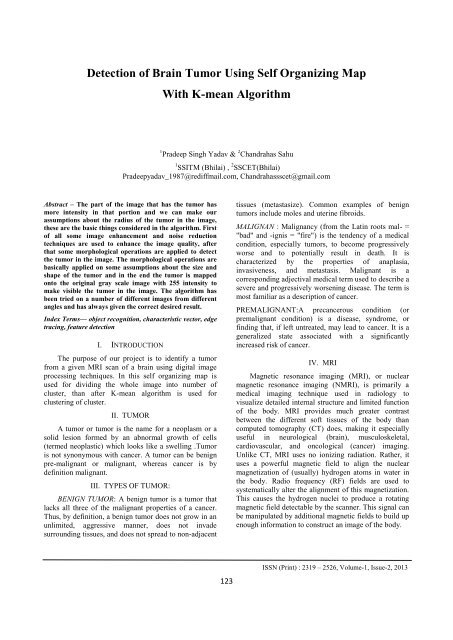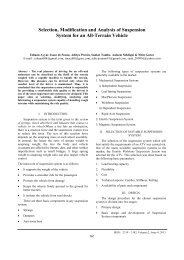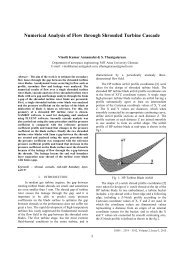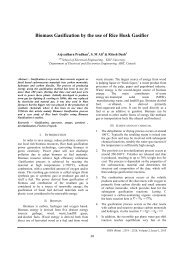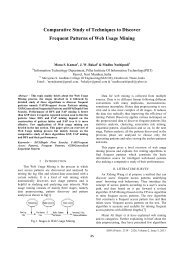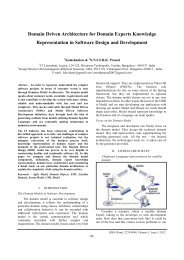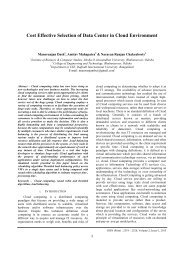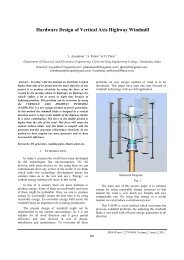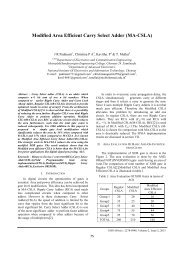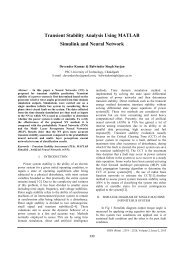Detection of Brain Tumor Using Self Organizing Map ... - IRD India
Detection of Brain Tumor Using Self Organizing Map ... - IRD India
Detection of Brain Tumor Using Self Organizing Map ... - IRD India
- No tags were found...
Create successful ePaper yourself
Turn your PDF publications into a flip-book with our unique Google optimized e-Paper software.
<strong>Detection</strong> <strong>of</strong> <strong>Brain</strong> <strong>Tumor</strong> <strong>Using</strong> <strong>Self</strong> <strong>Organizing</strong> <strong>Map</strong>With K-mean Algorithm1 Pradeep Singh Yadav & 2 Chandrahas Sahu1 SSITM (Bhilai) , 2 SSCET(Bhilai)Pradeepyadav_1987@rediffmail.com, Chandrahassscet@gmail.comAbstract – The part <strong>of</strong> the image that has the tumor hasmore intensity in that portion and we can make ourassumptions about the radius <strong>of</strong> the tumor in the image,these are the basic things considered in the algorithm. First<strong>of</strong> all some image enhancement and noise reductiontechniques are used to enhance the image quality, afterthat some morphological operations are applied to detectthe tumor in the image. The morphological operations arebasically applied on some assumptions about the size andshape <strong>of</strong> the tumor and in the end the tumor is mappedonto the original gray scale image with 255 intensity tomake visible the tumor in the image. The algorithm hasbeen tried on a number <strong>of</strong> different images from differentangles and has always given the correct desired result.Index Terms— object recognition, characteristic vector, edgetracing, feature detectionI. INTRODUCTIONThe purpose <strong>of</strong> our project is to identify a tumorfrom a given MRI scan <strong>of</strong> a brain using digital imageprocessing techniques. In this self organizing map isused for dividing the whole image into number <strong>of</strong>cluster, than after K-mean algorithm is used forclustering <strong>of</strong> cluster.II. TUMORA tumor or tumor is the name for a neoplasm or asolid lesion formed by an abnormal growth <strong>of</strong> cells(termed neoplastic) which looks like a swelling .<strong>Tumor</strong>is not synonymous with cancer. A tumor can be benignpre-malignant or malignant, whereas cancer is bydefinition malignant.III. TYPES OF TUMOR:BENIGN TUMOR: A benign tumor is a tumor thatlacks all three <strong>of</strong> the malignant properties <strong>of</strong> a cancer.Thus, by definition, a benign tumor does not grow in anunlimited, aggressive manner, does not invadesurrounding tissues, and does not spread to non-adjacenttissues (metastasize). Common examples <strong>of</strong> benigntumors include moles and uterine fibroids.MALIGNAN : Malignancy (from the Latin roots mal- ="bad" and -ignis = "fire") is the tendency <strong>of</strong> a medicalcondition, especially tumors, to become progressivelyworse and to potentially result in death. It ischaracterized by the properties <strong>of</strong> anaplasia,invasiveness, and metastasis. Malignant is acorresponding adjectival medical term used to describe asevere and progressively worsening disease. The term ismost familiar as a description <strong>of</strong> cancer.PREMALIGNANT:A precancerous condition (orpremalignant condition) is a disease, syndrome, orfinding that, if left untreated, may lead to cancer. It is ageneralized state associated with a significantlyincreased risk <strong>of</strong> cancer.IV. MRIMagnetic resonance imaging (MRI), or nuclearmagnetic resonance imaging (NMRI), is primarily amedical imaging technique used in radiology tovisualize detailed internal structure and limited function<strong>of</strong> the body. MRI provides much greater contrastbetween the different s<strong>of</strong>t tissues <strong>of</strong> the body thancomputed tomography (CT) does, making it especiallyuseful in neurological (brain), musculoskeletal,cardiovascular, and oncological (cancer) imaging.Unlike CT, MRI uses no ionizing radiation. Rather, ituses a powerful magnetic field to align the nuclearmagnetization <strong>of</strong> (usually) hydrogen atoms in water inthe body. Radio frequency (RF) fields are used tosystematically alter the alignment <strong>of</strong> this magnetization.This causes the hydrogen nuclei to produce a rotatingmagnetic field detectable by the scanner. This signal canbe manipulated by additional magnetic fields to build upenough information to construct an image <strong>of</strong> the body.123ISSN (Print) : 2319 – 2526, Volume-1, Issue-2, 2013
International Journal on Advanced Computer Theory and Engineering (IJACTE)V. METHODOLOGYThe part <strong>of</strong> the image containing the tumornormally has more intensity then the other portion andwe can assume the area, shape and radius <strong>of</strong> the tumorin the image. We have used these basic conditions todetect tumor in our code and the code goes through thfollowing steps: we present a new efficient edge tracingmethod, which was developed to find characteristicvector for the black-and-white images. The previouslyproposed edge tracing methods have two maindisadvantages. These are: The edge detection <strong>of</strong> onlyone object in case <strong>of</strong> more than one object in anumerical image and investigating only outer contoursnot inner contours.VI. FIGURESVII. PREPROCESSINGIn processing the following different steps arefollowed:-THRESHOLD SEGMENTATION:Segmentation isdone on basis <strong>of</strong> a threshold, due to which whole imageis converted into binary image. Basic matlab commandsfor thresholding are used for this segmentation.WATERSHED SEGMENTATION:It is the best methodto segment an image to separate a tumor but it suffersfrom over and under segmentation, due to which wehave used it as a check to our output. We have not usedwatershed segmentation on our input, rather it is onlyused on our output to check <strong>of</strong> the result is correct or notand it give the correct answer every time as is shownbelow.Morphological Operators:After that some morphological operations areapplied on the image after converting it into binaryform. The basic purpose <strong>of</strong> the operations is to showonly that part <strong>of</strong> the image which has the tumor that isthe part <strong>of</strong> the image having more intensity and morearea then that specified in the strel command.The basic commands used in this step are strel, imerodeand imdilate.Imerode():It is used to erode an image.Imdilate():It is used to dilate an imageIX. OUTPUTS/RESULTSWe have mapped the resultant tumor image onto theoriginal grayscale image for presentation purposes124ISSN (Print) : 2319 – 2526, Volume-1, Issue-2, 2013
International Journal on Advanced Computer Theory and Engineering (IJACTE)[3] Metin Akay, Time Frequency and Wavelets inBiomedical Signal Processing, IEEE Press Serieson Biomedical Engineering.[4] Starčuk Z, Starčuk jr, Horký J., ‘Baseline’problems in very short echo-time proton MRspectroscopy <strong>of</strong> low molecular weightmetabolites in the brain, Measurment ScienceReview, Vol.1, No.1, 2001, pp.17-20.[5] Weber-Fahr W, Ende G, Braus D, Bachert P,Soher J, Henn F, Buchel C., A Fully AutomatedMethod for Tissue Segmentation and CSF-Correction <strong>of</strong> Proton MRSI MetabolitesCorroborates Abnormal Hippocampal NAA inSchizophrenia, NeuroImage, Vol.16, 2002,pp.49–60.[6] Axelson D, Bakken I, Gribbestad I, Ehrnholm B,Nilsen G, Aasly J., Applications <strong>of</strong> NeuralNetwork Analyses to In Vivo 1H MagneticResonance Spectroscopy <strong>of</strong> Parkinson DiseasePatients, Journal <strong>of</strong> Magnetic ResonanceImaging, Vol.16, 2002, pp.13–20.X. REFERENCES[1] Bonavita S, Di Salle F, Tedeschi D., ProtonMRS in neurological disorders, European Journal<strong>of</strong> Radiology, No.31, 1999, pp.30-125.[2] Baik H, Choe B, Lee H, Suh T, Son B, Lee J.,Metabolic Alterations in Parkinson’s Diseaseafter halamotomy, as Revealed by 1H MRSpectroscopy, Korean J Radiol, Vol.3, No.3,2002, pp.180-9.125ISSN (Print) : 2319 – 2526, Volume-1, Issue-2, 2013


